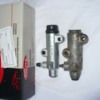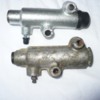Hi I recently was chasing some Ferrari parts and stumbled upon the correct alloy slave cylinder for the Goose. It is the correct finish and only requires the spring return lip to be cut off, just as the originals did.I looked at sleeving my old pitted one and decided for the going price of £35 (yes 35 not 350) it was not worth the trouble. The slave is off either a 330GTC or 275GTB/S. The usual european ferrari suppliers have them in stock. The cheapest seems to be Autoricambi d'epoca at 28 Euro or about $38 US. I have found him to be expensive for freight and either Maranello's or Eurospares are around £35.Unfortunately the US Ferrari parts carriers are a bit more expensive at $185 for the same item. Previously I have replaced one with a Fiat, I think 130 slave, however it was cast,but did the job. I will try to post some photos soon.
Original Post



